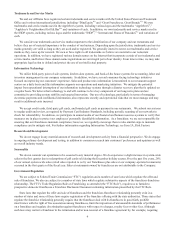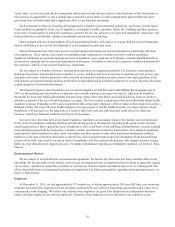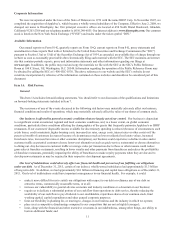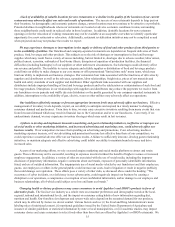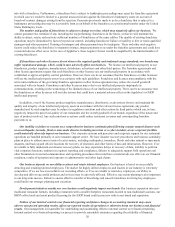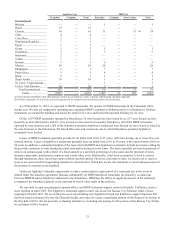IHOP 2015 Annual Report Download - page 35
Download and view the complete annual report
Please find page 35 of the 2015 IHOP annual report below. You can navigate through the pages in the report by either clicking on the pages listed below, or by using the keyword search tool below to find specific information within the annual report.15
A lack of availability of suitable locations for new restaurants or a decline in the quality of the locations of our current
restaurants may adversely affect our sales and results of operations. The success of our restaurants depends in large part on
their locations. As demographic and economic patterns change, current locations may not continue to be attractive or profitable.
Potential declines in neighborhoods where our restaurants are located or adverse economic conditions in areas surrounding
those neighborhoods could result in reduced sales in those locations. In addition, desirable locations for new restaurant
openings or for the relocation of existing restaurants may not be available at an acceptable cost when we identify a particular
opportunity for a new restaurant or relocation. Additionally, restaurant revitalization initiatives may not be completed as and
when projected and may not produce the results we expect.
We may experience shortages or interruptions in the supply or delivery of food and other products from third parties or
in the availability of utilities. Our franchised and company-operated restaurants are dependent on frequent deliveries of fresh
produce, food, beverage and other products. This subjects us to the risk of shortages or interruptions in food and beverage
supplies which may result from a variety of causes including, but not limited to, shortages due to adverse weather, labor unrest,
political unrest, terrorism, outbreaks of food-borne illness, disruption of operation of production facilities, the financial
difficulties (including bankruptcy) of our suppliers or other unforeseen circumstances. Such shortages could adversely affect
our revenue and profits. The inability to secure adequate and reliable supplies or distribution of food and beverage products
could limit our ability to make changes to our core menus or offer promotional "limited time only" menu items, which may
limit our ability to implement our business strategies. Our restaurants bear risks associated with the timeliness of deliveries by
suppliers and distributors as well as the solvency, reputation, labor relationships, freight rates, prices of raw materials and
health and safety standards of each supplier and distributor. Other significant risks associated with our suppliers and
distributors include improper handling of food and beverage products and/or the adulteration or contamination of such food and
beverage products. Disruptions in our relationships with suppliers and distributors may reduce the payments we receive from
our franchisees or our pancake and waffle dry mix distributors or the profits generated by our company-operated restaurants. In
addition, interruptions to the availability of gas, electric, water or other utilities may adversely affect our operations.
Our inability to effectively manage or forecast appropriate inventory levels may adversely affect our business. Effective
management of inventory levels depends, in part, on our ability to anticipate and respond in a timely manner to changing
consumer demand and preferences. From time to time, we may carry excessive inventory resulting from menu events that vary
from forecasted demand which may result in financial loss to the Corporation and/or to our franchisees. Conversely, if we
underestimate demand, we may experience inventory shortages which may result in lost revenues.
A failure to develop and implement innovative marketing and guest relationship initiatives, ineffective or improper use
of social media or other marketing initiatives, and increased advertising and marketing costs, could adversely affect our
business results. If our competitors increase their spending on advertising and promotions, if our advertising, media or
marketing expenses increase, or if our advertising and promotions become less effective than those of our competitors, we
could experience a material adverse effect on our business results. A failure to sufficiently innovate, develop guest relationship
initiatives, or maintain adequate and effective advertising could inhibit our ability to maintain brand relevance and drive
increased sales.
As part of our marketing efforts, we rely on search engine marketing and social media platforms to attract and retain
guests. These efforts may not be successful, resulting in expenses incurred without the benefit of higher revenues or increased
employee engagement. In addition, a variety of risks are associated with the use of social media, including the improper
disclosure of proprietary information, negative comments about our brands, exposure of personally identifiable information,
fraud, and use of outdated information. The inappropriate use of social media vehicles by our franchisees and their employees,
guests, our employees or others in the general public could increase our costs, lead to litigation or result in negative publicity
that could damage our reputation. These efforts pose a variety of other risks, as discussed above under the heading: “The
occurrence of cyber incidents, or a deficiency in our cybersecurity, could negatively impact our business by causing a
disruption to our operations, a compromise or corruption of our confidential information, and/or damage to our employee and
business relationships, all of which could subject us to loss and harm our brands.”
Changing health or dietary preferences may cause consumers to avoid Applebee's and IHOP's products in favor of
alternative foods. The food service industry as a whole rests on consumer preferences and demographic trends at the local,
regional, national and international levels, and the impact on consumer eating habits of new information regarding diet,
nutrition and health. Our franchise development and system-wide sales depend on the sustained demand for our products,
which may be affected by factors we do not control. Various factors such as: (i) the Food and Drug Administration’s menu
labeling rules of nutritional content, (ii) nutritional guidelines issued by the United States Department of Agriculture and
issuance of similar guidelines or statistical information by state or local municipalities, or (iii) academic studies, may impact
consumer choice and cause consumers to select foods other than those that are offered by Applebee's or IHOP restaurants. We






